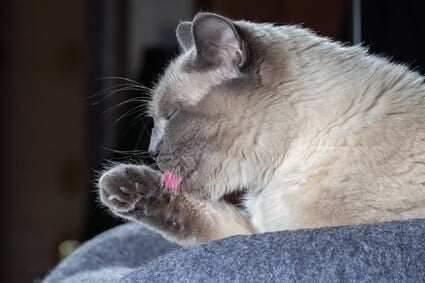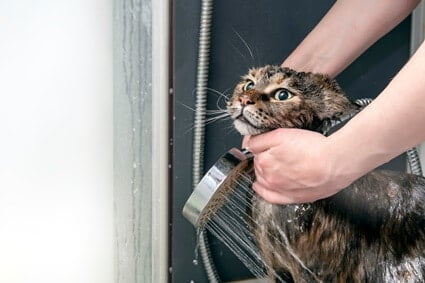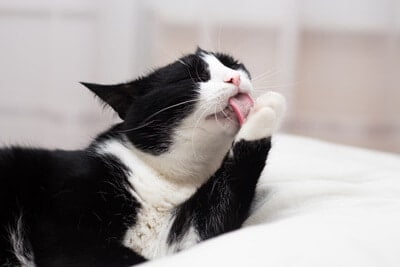Cats are dedicated groomers that like to keep themselves clean. In fact, they spend up to 5 hours a day grooming in smaller intervals. That makes it a little odd that your cat’s paws always seem to be dirty. Perhaps your cat explores outside for most of the day, or it’s suddenly unable to groom itself. No matter the case, you can help maintain its paws.
To clean your cat’s paws, start by removing the debris. Hardened cat litter should be softened with a damp rag or baby wipe. Tweezers may be necessary for cleaning out the claws. If there’s yellowing or poop stuck on the paws, use a wet rag and soapy water.
To ensure your cat stays clean, limit how much access it has to filth. This may include making your outdoor cat an indoor cat. You can also mop and shine your floors more often, so the cat doesn’t walk through dirt. Providing a bigger litter box can give the cat more room to clean itself before leaving. Litter mats can be placed around the box to catch any debris that it misses. Even trimming your cat’s nails will limit how much grime it can pick up.
Why Are My Cat’s Paws So Dirty?
Cats use their paws for everything, from walking to prodding new objects to killing prey. As such, they have ample chances to get dirty. You may discover your feline’s claws, paw pads, or its entire paws covered in:
- Dirt
- Poop
- Food
- Sticky substances
- Blood
- Dust
- Anything else it touched
Catching your feline with dirty paws now and then isn’t surprising. That’s especially true if it’s fresh from exploring outdoors. It may also be playing in interesting locales that get it dirty, such as an abandoned house or underneath a car. In these situations, the cat is grooming, but it’s getting so dirty that the filth is hard to keep up with.
Barring those exceptions, your cat shouldn’t always seem to have dirty paws. If it does, then it may be:
- Older and struggling to clean itself.
- Dealing with dirty residue on its paws that it can’t remove (even when it tries)
- Weaned too early, so it doesn’t quite understand how to groom itself properly.
- Sick, and therefore unwilling to take care of itself.
Do Cats Clean Their Paws?
Cats are dedicated to hygiene and maintain a strict grooming routine. In fact, according to the ASPCA, cats spend up to 5 hours every day cleaning themselves. This routine won’t just include licking at their fur. Your cat will also:
- Lick and clean its paws
- Rub its clean and dampened paws across its ears and face
- Lick the parts of its abdomen and underbelly that it can reach
- Rub up against other surfaces to clean spots it can’t reach
Rest assured: Cats are doing their best to keep themselves clean. There can be times, however, when your cat needs a helping hand.

Should I Clean My Cat’s Paws?
Older cats may struggle to maintain the same grooming routine as before. Cats with mobility issues may also struggle to reach certain areas. If your cat is very young, was weaned early, or is still a kitten, it may need to be trained to groom itself. Cats learn this from their mothers, but if your feline didn’t get the chance, it might not clean its paws right.
Sick cats may be unable to clean themselves, and extremely stressed cats may refuse. All this can leave your cat looking and feeling grimy. That will impact its mood even further and lead to behavioral issues.
So, while you shouldn’t normally have to clean your cat’s paws, there are times when it’s necessary. If you notice the feline isn’t properly caring for itself after several days, you can step in. That can involve:
- Teaching it how to groom
- Getting it treatment for whatever illness it’s experiencing
- Finding ways to make grooming easier
In the meantime (or in general, if treatment doesn’t help), you can wash your cat’s paws for it. As long as you leverage the right techniques, it should appreciate the help.
How Dirty Are My Cat’s Paws?
If your cat’s paws are dirty, and the cat is doing nothing about it, you shouldn’t ignore this. Dirty paws aren’t just messy for your home and unsightly to view. They can actually be dangerous to your (and your cat’s) health. Cat paws can harbor many types of bacteria.
A frequent illness that you can get from cats is cryptosporidiosis. This is an infection that causes intestinal upset. Many sub-species affect both animals and humans. Likewise, toxoplasmosis affects many parts of the body and can be carried by many pets, according to Frontiers in Veterinary Science.
A healthy person shouldn’t worry too much about these infections. Your immune system can likely handle it with enough rest and nutrients. However, if your cat is routinely bringing in filth or you have compromised health, that’s bad news. You’ll need to help your cat maintain tidier claws to avoid getting sick.
Best Way To Clean Cats’ Paws
You can’t just walk up to a cat and start washing its paws. Oftentimes, it will pull away from you, flee, or even react aggressively. If this is going to be a regular grooming session, you need to help your cat feel secure. Start by:
- Getting the cat used to its paws being held: Start with touching the paws regularly and then massaging them. The cat will realize being touched here doesn’t hurt or cause discomfort.
- Inspect the paws: Do a routine inspection at least twice a day. Look for dirt, cuts, or stains. This helps you know when grooming is needed but also gets your cat used to the process.
- Avoid cross-contamination: Always be vigilant about bacteria! Wash any rags you use, wash your hands, and clean the sink where you disinfected your things.
With those preliminaries handled, you can now move on to the actual cleaning.
How To Clean Cat Litter From Paws
Litter may get stuck to your cat’s paws, so start by loosening it. Dip the paws in a shallow bowl of soapy water. Alternatively, you can soak a rag and press it against your cat’s paw. Some felines will tolerate this more than others, so multiple applications may be necessary.
Once the litter is softened, use a second damp rag to remove the pieces. Gently hold your cat’s paws with your non-dominant hand. Then, pick off the litter with a rag dipped in a bowl of soapy water. If the litter is too hard, dip the paw again for 1-2 minutes before scrubbing with the rag.
How To Clean Poop Off Cat’s Paws
Poop may get stuck on the paw pads or the fur surrounding the cat’s little foot. You can use a fine-tooth comb to remove debris.
Hardened poop will need to be softened before you try to remove it. Otherwise, you risk hurting your cat when pulling on its fur. To do this, use unscented baby wipes or a moistened rag. A shampoo mixture will also help in softening poop that is stuck firmly.
That mixture will need to be 5-parts water to 1-part shampoo. Dip a rag in the mixture, press it against the cat’s foot for 1-2 minutes, and wipe off the poop.
Alternatively, you can use cat wipes. These are specially made to remove filth from cats, be it eye stains or poop. They are unscented and won’t dry out your cat’s skin. If this is a regular problem for your cat, it may be worth the investment to avoid irritating its paws.
How To Clean Cats’ Claws
To remove debris caught in your feline’s claws, use a tweezer. Gently hold your cat’s paw with one hand, and remove debris using the other.
Once the large chunks are clear, brush away any debris too small for tweezers. This can be done with a toothbrush, nail brush, or dental brush. It depends on your cat and how well it tolerates its claws being handled.
Be sure to soak the brush in warm, soapy water before proceeding. Clean the tool afterwards as well to avoid infection.
For any remaining dirt, wipe your feline’s claws with a damp, soapy cloth. This will take care of any smaller particles and provide a good finish to your cat’s manicure.
Yellow On Cats Paws
If your cat’s paws are yellow, this is usually staining. There are few yellow items in nature that can mark a cat’s paws this color. Likewise, unless you have yellow paint in your home, the cat probably interacted with:
Corn-Based Litter
Litter made from corn (or corn cobs) may cause yellow staining on a cat’s fur. When moisture is added, corn-based litter turns to dust, which can leave behind a residue. The good news is, this yellowing is non-toxic.
Your cat may try to lick the mark off, and this is completely safe. You can try to bathe the cat to reduce the color, but mild staining could persist, especially on light-colored cats.
The worst part is that corn-based litter can be tracked throughout your home, staining clothes and other fabrics. Darker material can be washed with soap and water. Lighter materials may need bleaching.
Urine
Most likely, your cat’s yellowed paws are coated in urine. This is especially common for older cats, cats with mobility issues, or those that are sick. If they cannot groom themselves, the urine will stay put and leave a stain.
You can verify if this is the case by smell. Urine stains often affect the front and back paws in equal amounts (though sometimes more in the back than the front). The belly, too, can be stained.
If your cat is too ill to groom, bathing your cat may cause unnecessary stress. Instead, wait until your cat regains its health. After that, it will groom itself readily and get rid of the urine.
For senior cats, a gentle bath can help alleviate the smell. A few passes with a baby wipe can fix this issue in short order.
How To Keep Cat Paws Clean
If your cat’s paws are always dirty, you don’t have to resign yourself to a life of cleaning. Here are ways to lessen the filth your cat accumulates on its paws.
Use A Litter Mat
Litter mats can be placed outside of the cat’s litter box. This allows it to traipse over them as it exits the box. They will trap any stray litter, and as a plus, more abrasive designs can even clean the paws off.
The best mats have angled ridges, which help to dislodge filth from a cat’s paw. Double-layered mats can also be separated into two, trapping litter in between. This design is a good choice if you don’t want to clean the mat itself.

Use The Right Litter Box
Certain litter boxes are specifically designed to lessen the amount of filth that your cat tracks on the floor. For example, closed litter boxes have an exit on top, surrounded by ridges. This works to drop litter right back into the box.
However, the problem can be more easily fixed by purchasing a larger box. If the cat lacks the space it needs to move around and clean its feet, it will track litter everywhere. It may also refuse to use the box since it feels cramped. Upgrading to a bigger size could allow the cat to fix the problem on its own.
Use The Right Litter
Some types of litter will stick to a cat’s paws more than others. For example, clumping litter can easily harden around the claws. You can switch to a different brand to resolve that issue.
Keep Your Floors Clean
Litter boxes aren’t the only reason for a cat’s dirty paws. Your floors, too, can be a culprit. The feline may be traipsing through dust, dirt, and random spills throughout the day. By vacuuming, sweeping, or mopping your floors once a week (or more often), the cat won’t struggle to maintain its grooming habits.
Keep Your Cat Indoors
With that said, clean floors are nothing if your cat still goes outdoors. While outside, it can pick up dirt, tree sap, the feces of other animals, and even more harmful substances like pesticides. If you want to keep your cat’s paws cleaner, think about making it an indoor cat.
Trim Nails
If your cat routinely has grim, dirt, or poop around its claws, you can trim them. Be sure to use a pair of clippers designed specifically for pets. This will avoid accidentally nipping the quick.
A cat’s paws will remain clean without your help. Cats naturally groom themselves, their nails and feet included. If your cat is unable to manage this by itself, you can intervene. Soap, a damp cloth, or baby wipes will be all it takes.

